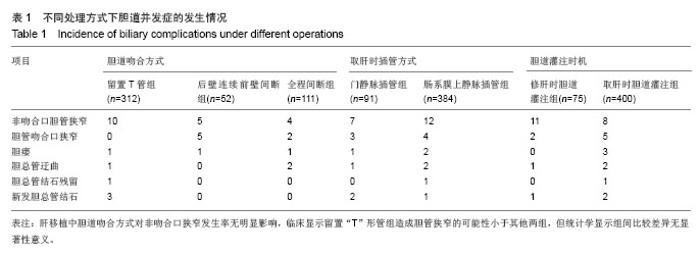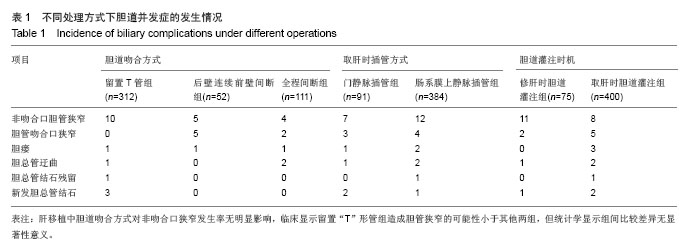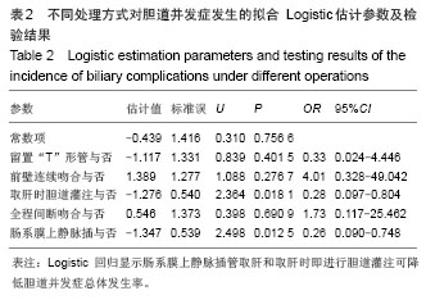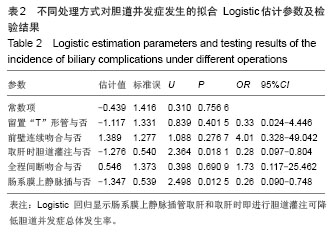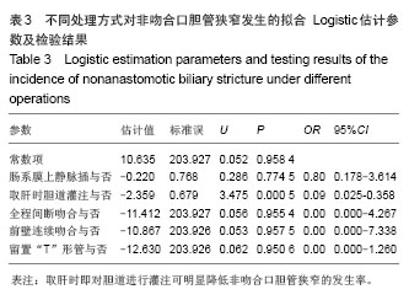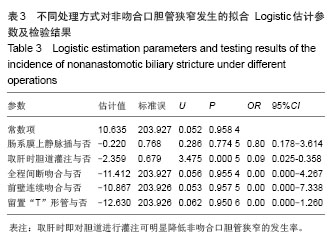| [1]Safdar K, Atiq M, Stewart C, et al. Biliary tract complications after liver transplantation. Expert Rev Gastroenterol Hepatol. 2009;3(2):183-195.
[2]Kochhar G, Parungao JM, Hanouneh IA, et al. Biliary complications following liver transplantation. World J Gastroenterol. 2013;19(19):2841-2846.
[3]唐彬,王宇,周杰,等.肝移植术后胆道并发症的危险因素分析[J].中国普通外科杂志,2011,20(1):1-5.
[4]Chan CH, Donnellan F, Byrne MF, et al. Response to endoscopic therapy for biliary anastomotic strictures in deceased versus living donor liver transplantation. Hepatobiliary Pancreat Dis Int. 2013;12(5):488-493.
[5]Gómez CM, Dumonceau JM, Marcolongo M,et al.Endoscopic management of biliary complications after adult living-donor versus deceased-donor liver transplantation.Transplantation. 2009;88(11):1280-1285.
[6]Zimmerman MA, Baker T, Goodrich NP, et al.Development, management, and resolution of biliary complications after living and deceased donor liver transplantation: a report from the adult-to-adult living donor liver transplantation cohort study consortium.Liver Transpl. 2013;19(3):259-267.
[7]霍枫,汪邵平,蒲淼水,等.肝移植围胆道重建环节技巧与细节对胆道并发症的影响研究[J].中国实用外科杂志,2011,31(11): 1035- 1037.
[8]邢天宇,夏强.成人活体肝移植胆道重建技术进展[J].肝胆外科杂志, 2011,19(4):311-313.
[9]宋继勇,石炳毅,杜国盛,等.肝脏移植术后非吻合口胆管狭窄的病因与防治[J].解放军医学杂志,2003,28(10):861-863.
[10]Li T,Chen ZS,Zeng FJ,et al.Impact of early biliary complications in liver transplantation in the presence or absence of a T-tube a Chinese transplant centre experience. Postgrad Med J. 2007;83(976):120-123.
[11]Shimoda M, Saab S, Morrisey M, et al. A cost-effectiveness analysis of biliary anastomosis with or without T-tube after orthotopic liver transplantation. Am J Transplant. 2001;1(2): 157-161.
[12]蔡金贞,朱志军,杨靖波,等.肝移植中胆道重建留置T管利弊前瞻性对照研究[J].广东医学,2009,30(3):370-372.
[13]Lin C H, Yu J C, Chen T W, et al. The experience of biliary tract complications after liver transplantation. Transplant Proc. 2007;39(10):3251-3256.
[14]Weiss S, Schmidt SC, Ulrich F, et al. Biliary reconstruction using a side- to-side choledocho-choledochostomy with or without T-tube in deceased donor liver transplantation: a prospective randomized trial.Ann Surg.2009;250(5):766-771.
[15]HaberalM, Boyvat F, Moray G, et al. A new technique for bile duct reconstruction in liver transplantation. Transplant Proc. 2006;38:584-588.
[16]Liu CL, Lo CM, Fan ST.What is the best technique for right hemiliver living donor liver transplantation? With or without the middle hepatic vein? Duct-to-duct biliary anastomosis or Roux-en-Y hepaticojejunostomy?J Hepatol. 2005;43(1): 17-22.
[17]Haberal M, Karakayali H, Sevmis S, et al.Intraoperative transhepatic biliary catheter insertion technique for biliary reconstruction: early results.Transplant Proc. 2007;39(4): 1184-1186.
[18]Pavlidis TE, Symeonidis NG, Psarras K, et al. Laparoscopic cholecystectomy in patients with cirrhosis of the liver and somptomctic cholelithiasis. JSLS. 2009;13(3):342-345.
[19]Mancero JM, D’ Albuquerque LA, Gonzalez AM, et al. Laparoscopic cholecystectomy in cirrhotic patients with symptomatic cholelithiasis: a case-control study. World J Surg. 2008;32(2):267-270.
[20]Chen CH, Huang MH, Yang JC, et al. Prevalence and risk factors of gallstone disease in an adult population of Taiwan an epidemiological survey. J Gastroenterol Hepatol. 2006; 21(11):1737-1743.
[21]Acalovschi M, Dumitrascu DL, Nicoara CD. Gallblader contractility in liver cirrhosis comparative study in patients with and without gallbladder stones. Dig Dis Sci. 2004;49(1): 17-24.
[22]Buza? C, Chira O, Mocan T, et al.Comparative study of gallbladder motility in patients with chronic HCV hepatitis and with HCV cirrhosis.Rom J Intern Med. 2011;49(1):37-44.
[23]Chen G, Wang S, Bie P, et al. Endogenous bile salts are associated with bile dult injury in the rat liver transplantation model. Transplantation. 2009;87(3):330-339.
[24]Yska MJ, Buis CI, Monbaliu D, et al. The role of bile salt toxicity in the pathogenesis of bile dult injury after non-heart-beating porcine liver transplantation. Transplantation. 2008;85(11):1625-1631.
[25]Hoekstra H, Porte RJ, Tian Y, et al. Bile salt toxicity aggravates cold ischemic injury of bile ducts after liver transplantation in Mdr2+/- mice.Hepatology, 2006;43(5): 1022-1031.
[26]Gulsen MT, Girotra M, Cengiz-Seval G, et al. HTK preservative solution is associated with increased biliary complications among patients receiving DCD liver transplants: a single center experience. Ann Transplant. 2013;20(18): 69-75.
[27]Rayya F, Harms J, Martin AP,et al.Comparison of histidine-tryptophan-ketoglutarate solution and University of Wisconsin solution in adult liver transplantation.Transplant Proc. 2008;40(4):891-894.
[28]Ko JS, Kim GS, Gwak MS, et al.Greater hemodynamic instability with histidine-tryptophan-ketoglutarate solution than University of Wisconsin solution during the reperfusion period in living donor liver transplantation.Transplant Proc. 2008; 40(10):3308-3310.
[29]祝峰,艾秋宝,张诚华.胆管周围血管丛损伤与肝移植术后胆道并发症[J].中国组织工程研究与临床康复,2011,15(53): 10018- 10022. |
